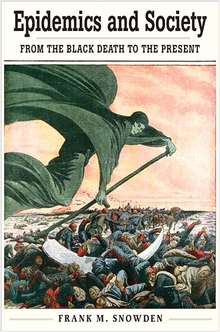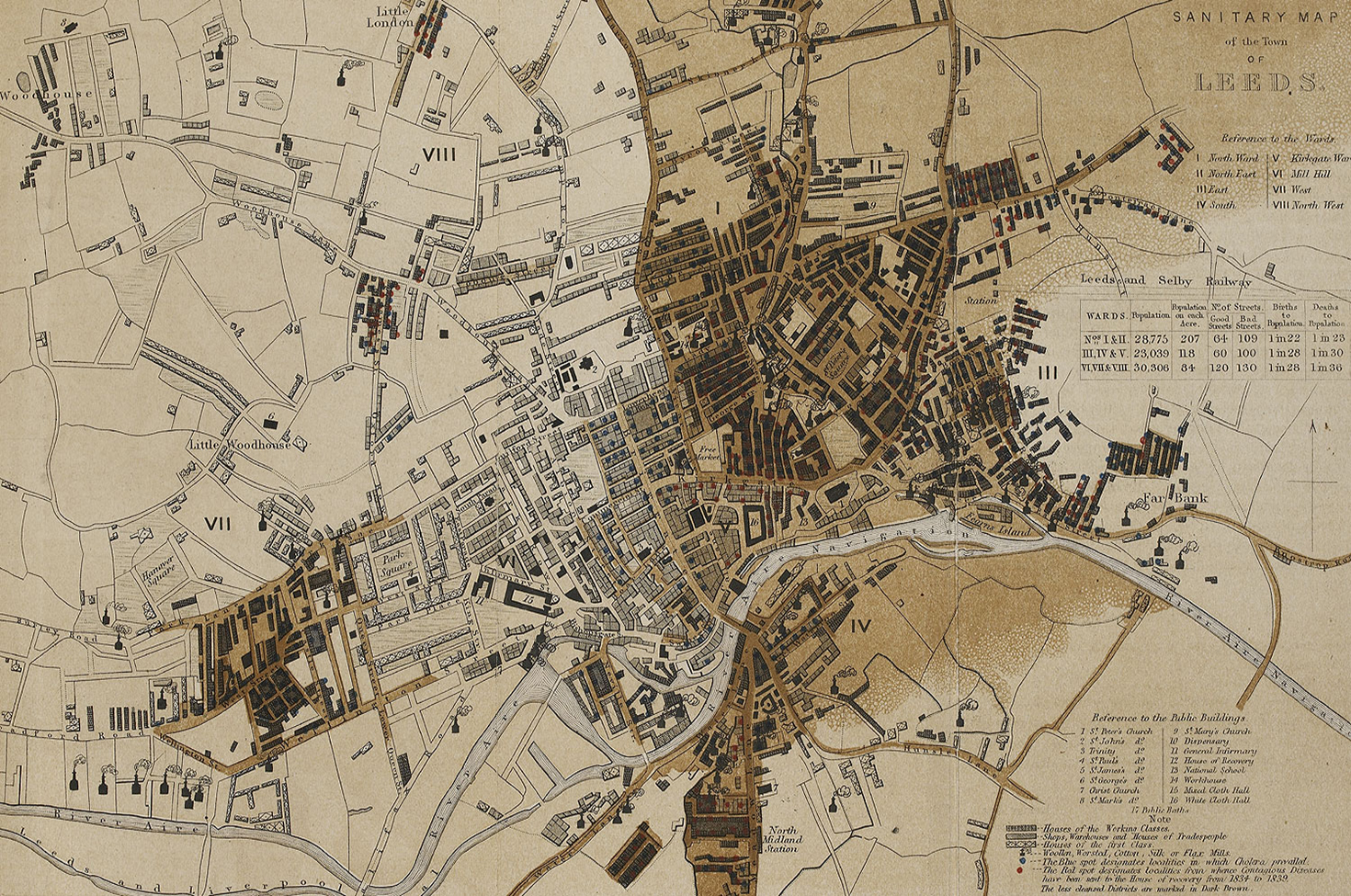
Sanitary map of Leeds, from the Report on the Sanitary Conditions of the Laboring Population of Great Britain, by Edwin Chadwick, 1842. British Library.
The founder of the sanitary movement was not a physician and had little interest in medicine. Edwin Chadwick was instead a barrister from Manchester. He was also a disciple of the liberal political economist and social reformer Jeremy Bentham. By the time he turned his attention to health, Chadwick had already gained notoriety as the reformer of the “Poor Laws” that constituted England’s provision for the health and welfare of the indigent. Relief during times of distress was the birthright of all Britons and was available in their native parishes. Chadwick’s view was that public assistance through the Poor Laws created a vicious and counterproductive downward spiral in which welfare fostered demoralization, dependence, and indolence. The inevitable result was to breed further poverty. In the process, the system also imposed a heavy burden on local property owners, whose local real estate taxes, or “rates,” funded public assistance. In a statement of one of his leading articles of faith, Chadwick proclaimed that “indigence cannot be made generally to disappear simply by grants of money.”
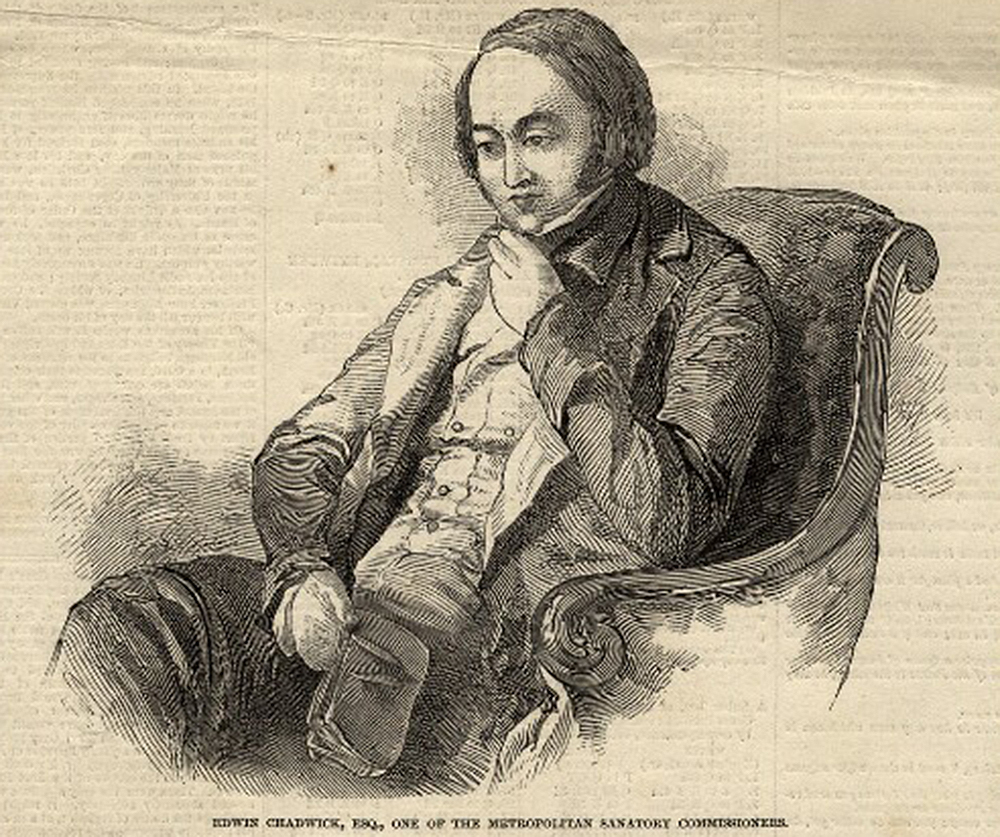
Chadwick’s solution to the problem was embodied in the so-called New Poor Law of 1834, which was founded on laissez-faire principles and belief in the free market. The measure, drafted jointly by Chadwick and the economist Nassau William Senior, had two major objectives. The first was to centralize the administration of the system in order to achieve uniformity of policy. The second was to make welfare so repugnant that only the truly desperate—the “deserving poor”—would seek support. Recipients would be compelled to accept residence in workhouses, where they would receive the necessities of life but under conditions that would make them long for any available outside employment. Families in workhouses were separated—parents from children and husbands from wives. The food was purposefully cheap and unappealing, surveillance was constant, and the work was designed to be more unpleasant and boring than any to be found outside the walls of the institution. In his novel Oliver Twist, an incisive critique of the New Poor Law published serially during 1837–39, Charles Dickens described workhouses as offering people the brutal choice of starving slowly within or rapidly outside. Chadwick and his followers termed the ethical basis of workhouses the principle of “least eligibility.” The poor found the application of the principle cruel, but ratepayers approved.
Chadwickian Poor Law reform and the sanitary movement that followed were both applications of the Benthamite perspective of directing centralized state power to solve the problems of urban modernity. Rapid urbanization and industrialization led to a seemingly ever-growing train of social problems concentrated in Britain’s towns and cities. Two were especially worrying—poverty and disease. Having dealt with poverty through Poor Law reform, Chadwick turned his attention to the other devastating affliction of the Victorian city—epidemic disease. In particular, he and his fellow reformers concerned themselves with the scourges of consumption (tuberculosis), cholera, smallpox, scarlet fever, and “typhus,” which was a diagnosis that included the infection known today as typhoid fever. Poor Law reform and the sanitary movement were governmental initiatives to deal with the economic and the medical facets, respectively, of the Victorian urban problem so vividly portrayed in London by Dickens and Henry Mayhew and in Manchester by Friedrich Engels.
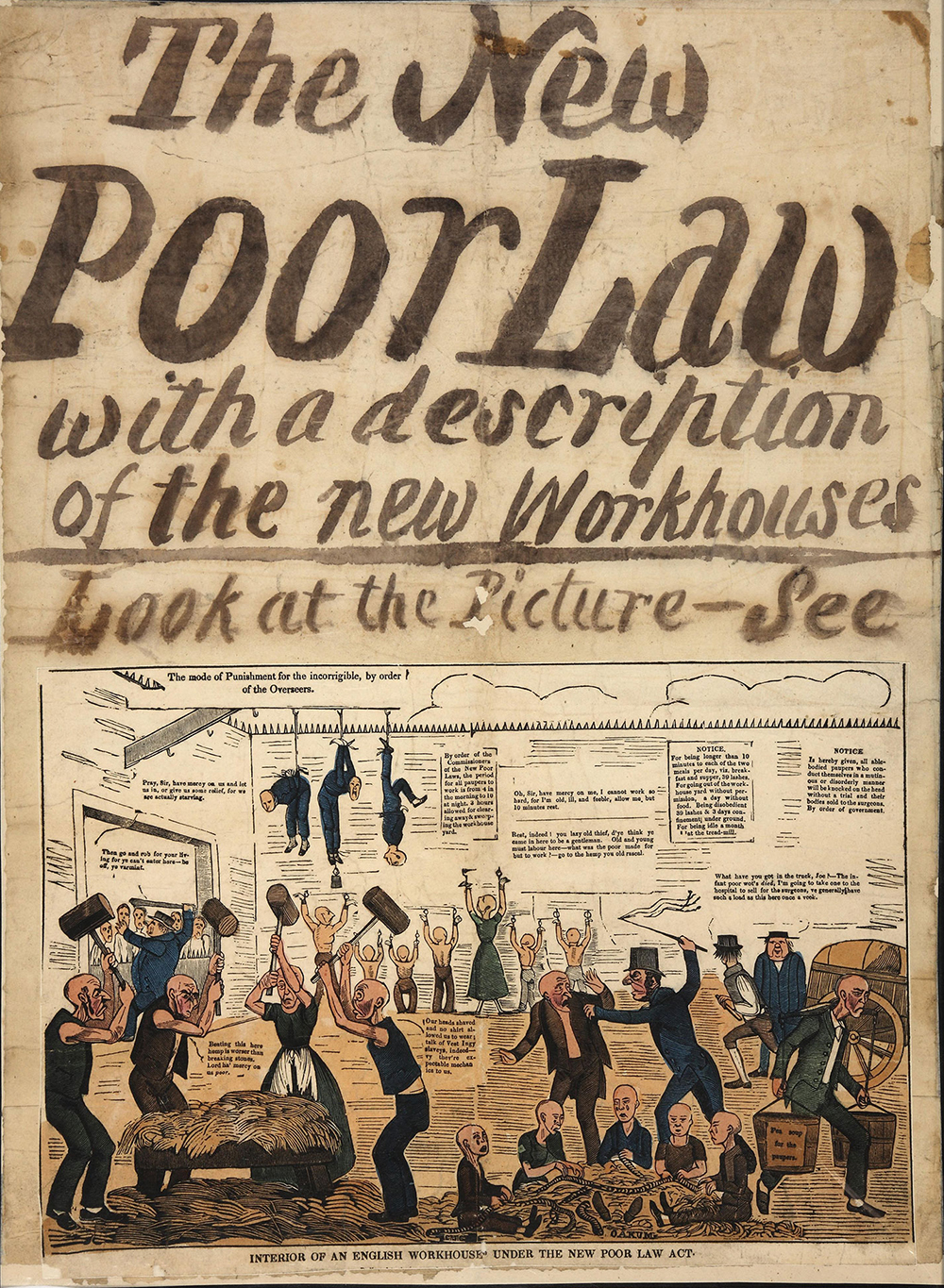
Sanitary and Poor Law reform were more, however, than just sequential efforts to confront the social pathologies of the mid-nineteenth-century English city. Poor Law reform in some measure actually led to the sanitary movement. The centralized state apparatus of relief after 1834 gathered extensive data concerning the ravages of disease in the overpopulated, poorly housed, and impoverished cities of the period. Indeed, the Poor Law bureaucratic machinery became the mechanism that was employed to document the catastrophic urban conditions that required urgent action.
The New Poor Law also powerfully affected the nature of the sanitary movement by determining the issues that public health policy did not address. In the 1830s, when Chadwick turned his attention to disease, a leading current of medical opinion held that poverty was a major driver of ill health and that wage reform was therefore a necessary component of any campaign to ameliorate health. Most prominent among those who held this view was William Pulteney Alison, a philanthropist and professor of medicine at the University of Edinburgh. Alison argued that economic hardship was not simply one of many factors promoting disease but rather its leading determinant.
Chadwick and his movement, however, carried the day with the counterargument that the chain of causation ran in precisely the opposite direction—that disease generated poverty rather than the reverse. Individual irresponsibility was the source of both. Furthermore, Chadwick believed that the New Poor Law had already addressed the issue of indigence by providing the poor with incentives to help themselves while supporting those who were genuinely unable to work and therefore to earn. It was logical, therefore, that he and the other veterans of Poor Law reform resolutely excluded wage levels, working conditions, and economic exploitation from their purview as matters irrelevant to disease.
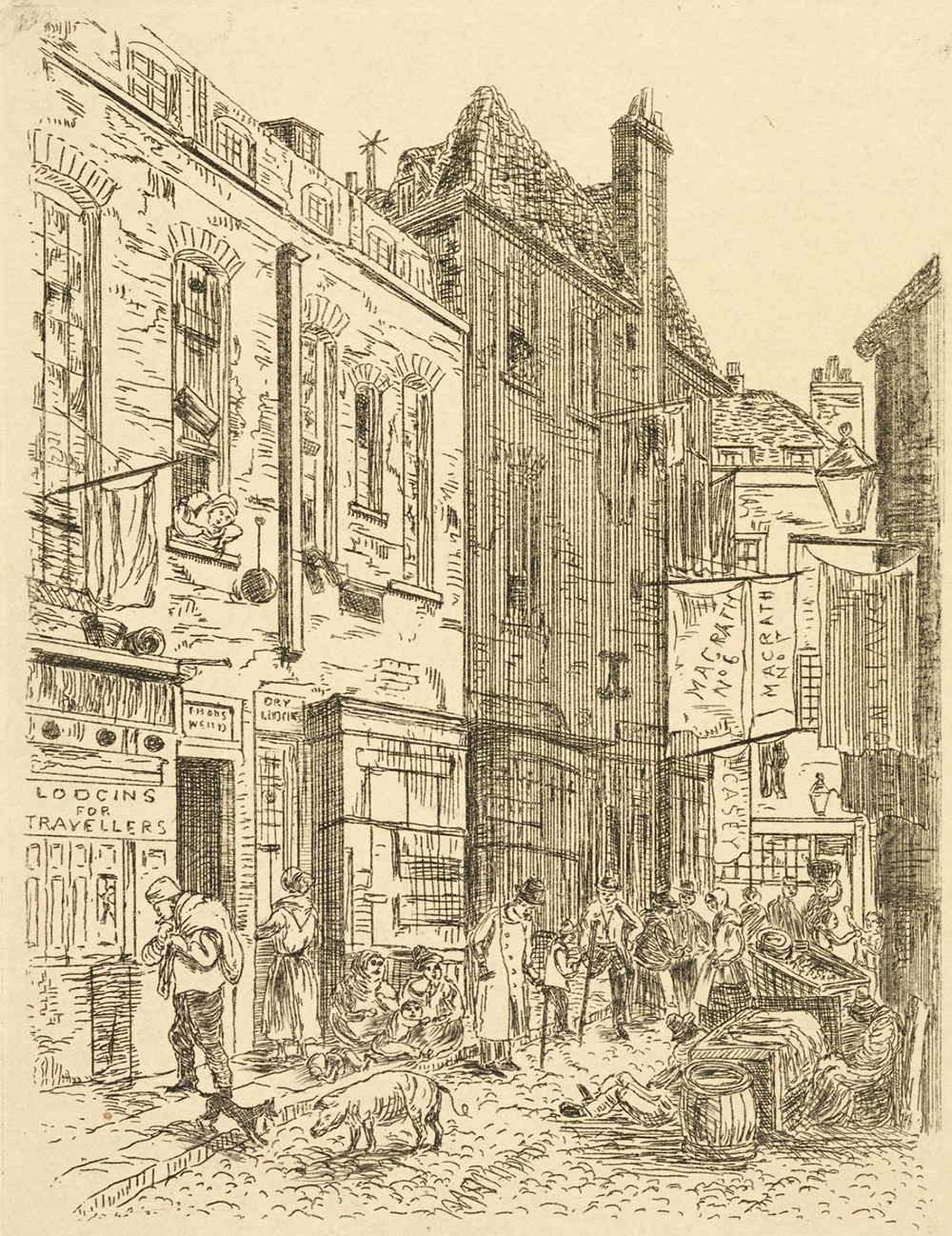
Given that Chadwick was not a man of science or medicine, the most important theorist in establishing the medical philosophy underpinning the sanitary movement was Thomas Southwood Smith. He was cofounder of the sanitary idea and Chadwick’s closest associate and fellow Benthamite. Southwood Smith had received his medical education at Edinburgh, but the turning point in his understanding of the etiology of disease was his appointment to the London Fever Hospital in the impoverished East End. Practicing there for nearly the whole of his career, he had ample occasion to observe the abysmal living conditions and medical afflictions of the handloom weavers of Bethnal Green and Whitechapel. A Unitarian preacher as well as a doctor, he was appalled by the wretchedness of the workers, their ill health, and what he regarded as their moral and spiritual depravity. It made sense to him, as it did to Chadwick, that the filth in which they led their lives destroyed their physical health just as it undermined their humanity, leading them to intemperance, indebtedness, and debauchery.
It was no novelty, of course, to link epidemic diseases to airborne miasmas. Until the Enlightenment, however, the dominant interpretation was that a miasma was a corruption of the air resulting from a major cosmic event—an inauspicious conjunction of the stars or a climatic change in temperature or humidity. What was new, and most fully developed by Southwood Smith, was the “filth theory of disease.” This theory still held that disease was caused by miasma, but the origin of the miasma was decaying filth in the microcosm of a specific neighborhood, community, or village.
In the filth etiology of disease, climatic factors had a presence not as “exciting” causes but only as remote or “predisposing” causes that operated indirectly—as in the case of heat and moisture—by promoting more rapid and intense putrefaction and by weakening the resistance or “animal energy” of the population.
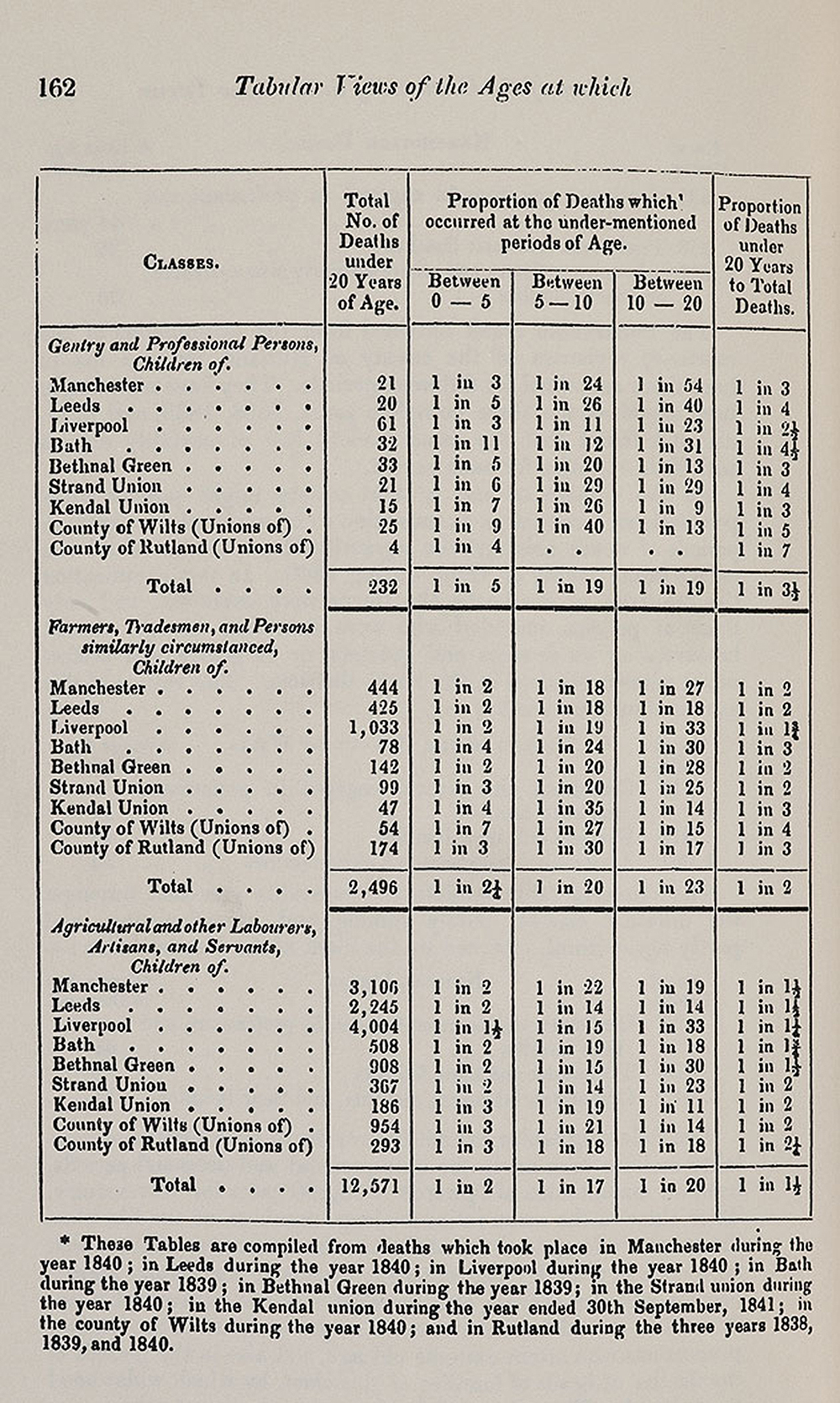
Given the filth theory, the means to prevent disease were immediately knowable. Like their colleagues in Paris, English sanitarians turned to the remedy of urban cleanups. As disciples of Bentham, however, they believed in the efficacy of using state power to tackle the problem centrally, forcefully, and systematically on a national level. It was no coincidence that the sanitarians in Britain brought their reforms to a climax through the passage by Parliament in 1848 of a Public Health Act and the creation of a General Board of Health. In the case of Southwood Smith and his fellow Unitarians, the imperative to act was all the more powerful because it was religiously grounded as well. Preventing disease and sin through cleanliness would demonstrate God’s benevolent ways toward humanity by showing that suffering arose through human neglect and that it could be easily prevented in a society of individuals of goodwill. Sanitation, therefore, was a moral and humanitarian imperative.
Chadwick’s approach to public health was to begin his labors by carrying out—at his own expense—an exhaustive study of the poverty and ordure that burdened the working classes throughout Britain. He believed that the sheer volume and shock of the information he collected would establish the case for the filth theory, silence potential opposition, and galvanize the country to act. These were the purposes of his monumental work of 1842, Report on the Sanitary Condition of the Laboring Population of Great Britain—known more briefly as his Sanitary Report. This report is one of the foundational texts of modern public health, and it instantly became a best seller. Chadwick’s procedure was to gather firsthand information through the bureaucratic apparatus of the New Poor Law system that he had helped to create. Together with his fellow Poor Law commissioners, Chadwick sent out questionnaires and solicited reports—thousands of them—from the Poor Law assistant commissioners and the physicians associated with them in localities throughout England. In Scotland, where the Poor Law system did not apply, he relied instead on an ad hoc network of medical officers, factory inspectors, and local doctors. In order to leave no informed and persuasive voice unheard, Chadwick also sought the views of prominent medical men outside the Poor Law administration and of notable men of letters. Having collected the reports from all of these sources over a period of three years, he sifted, edited, abridged, and arranged them. He also added his own commentary, based on an overview of the material and on personal tours of inspection that he conducted to observe and document conditions for himself. Before publication he also sent drafts to leading medical authorities for their approval and comments.
What emerged was a detailed and documented description of the horrifyingly sordid living conditions of workers throughout the nation—agricultural laborers, artisans, miners, factory workers, and handloom weavers. The impact of the tableau that emerged was especially powerful because in all cases the sources of the information were unimpeachable and, apart from Scotland, official. Everywhere the human consequences of the agricultural revolution, the Industrial Revolution, mass urbanization, and massive population growth were apparent. Overcrowding, poverty, filth, and stench were ubiquitous. Such results were not entirely surprising in huge cities such as London, Manchester, and Glasgow, but unexpectedly, similar conditions were found to prevail in small towns and villages as well.
In literature Charles Dickens became the standard bearer for sanitary reform. Early in his career Dickens had bitterly opposed Chadwick and the New Poor Law, which he caricatured in Oliver Twist. From the early 1840s, however, he became a lifelong convert to sanitation and to its practical application in the reform program of Chadwick, his former bête noire. As he wrote to a mutual friend in 1842, after reading a copy of what he called the “excellent” Sanitary Report, “Pray tell Mr. Chadwick that I heartily concur with him in the great importance and interest of the subject though I do differ with him, to the death, on his crack topic—the new Poor Law.”
Soon after meeting Chadwick in person, Dickens began to incorporate the miasmatic and filth theories into his novels, starting with Martin Chuzzlewit and Dombey and Son, where the concepts are clearly delineated. Then in 1850, when Chadwick, as a member of the General Board of Health, was at the height of his efforts to implement his cleansing program, the novelist took two steps forward as a sanitarian in his own right. First, Dickens founded the weekly periodical Household Words that gave pride of place to sanitation and transformed him into the foremost public spokesman for Chadwick’s movement. In that guise he even addressed the Metropolitan Sanitary Association on the need for hygienic reform. Although Dickens was a socialist and Chadwick a staunch defender of the existing social order, they agreed that sanitation was the most effective means of reducing human suffering.
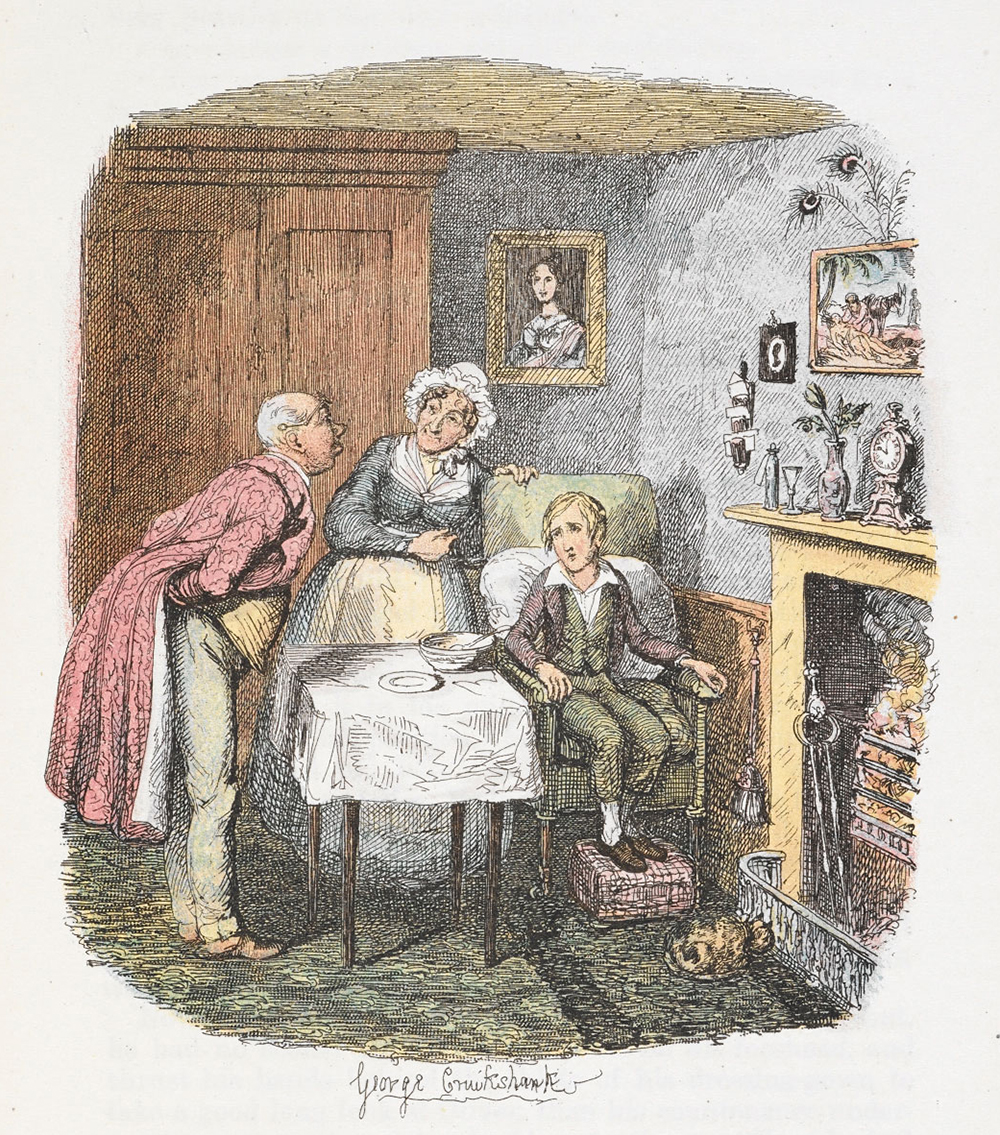
Dickens was not the only Victorian writer to make sanitary reform a significant element in his work. Some historians have identified what they call the “sanitary novel.” In addition to works by Dickens, the list of candidates for the designation include George Eliot’s Middlemarch (1871), Elizabeth Gaskell’s North and South (1855), and Benjamin Ward Richardson’s Hygeia: A City of Health (1876). All of these writings confront the evils of filth, and they call for cleansing as a means of promoting both health and beauty.
Sanitation also influenced painting. The most important figure is the art critic and social theorist John Ruskin. An ardent opponent of filth and admirer of the sanitary reformers, Ruskin was regarded even by Chadwick as a fellow sanitarian. In his Modern Painters, which is laced with the sanitarian lexicon of filth, disease, and foul odor, Ruskin criticized the Old Masters in the name of health, which he raised to the level of an aesthetic ideal. He chastised Rembrandt because of such features as his dark palette, which was suggestive of dirt, and his interiors, which were lit by candles and filled with shadows rather than health-giving sunlight. Only sanitary art could reach the highest ideals of beauty, Ruskin theorized. Rembrandt’s canvases, Ruskin specifically objected, were “unromantic and unhygienic.” By contrast, he extolled J.M.W. Turner’s landscapes for their bright colors extending even to white, and for their direct depiction of sunlight. Such work, according to Ruskin, was modern, hygienic, and romantic. Sanitation helped to further a change of style and sensibility in the arts, associating modernity with clarity of line, bright tones, and vivid colors. All that was dark was dirty, stinky, and abhorrent. It also provided a precondition for the emergence of the Pre-Raphaelites, who made use of recent chemical advances to create strikingly bright pigments.
Fashions in interior decoration also evolved rapidly under the force of the sanitary idea. Traditionally, the comfortable classes in mid-Victorian England filled their sitting rooms with all that was heavy, intricate, dark, and cluttered—drapes, sturdy furniture, rugs, paintings. Everywhere was a profusion of ornament, and every surface was covered with endless bric-a-brac. To sanitarian taste, such furnishings were dangerous receptacles for dust, traps for miasmatic atoms, and bearers of the silent imputation of filth. Post-sanitarian decorators, in harmony with the priorities of Ruskin and the designer and writer William Morris, moved instead in the direction of simplicity, light tonalities, and clear lines. Modernity everywhere was bright, clean, and in harmony with the latest thinking in science and technology.
Excerpted from Epidemics and Society: From the Black Death to the Present by Frank M. Snowden, new from Yale University Press. Copyright © 2019 by Frank M. Snowden. Published by permission. All rights reserved.
